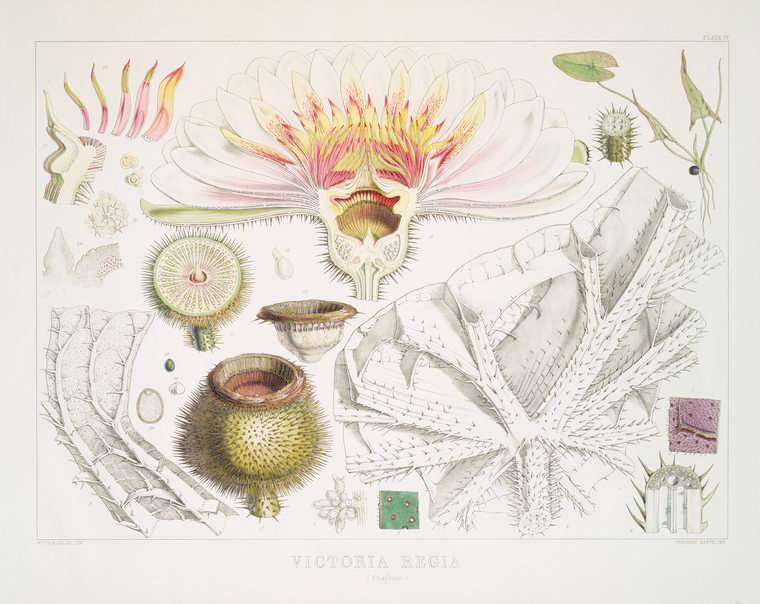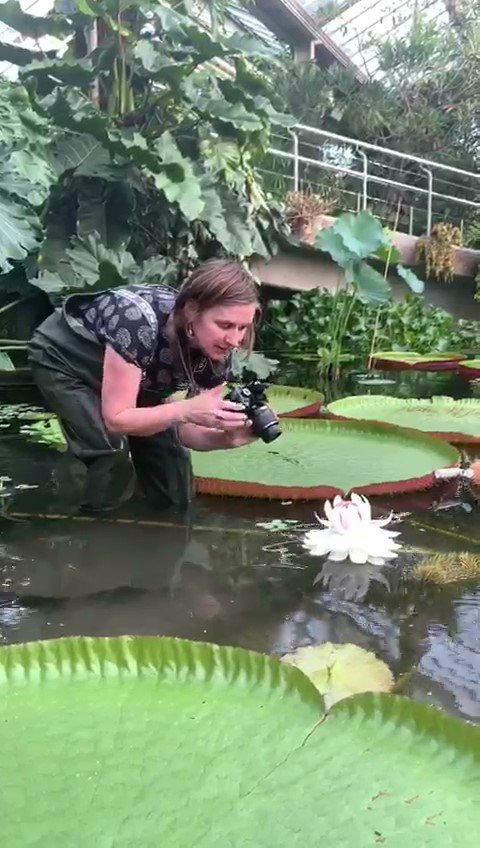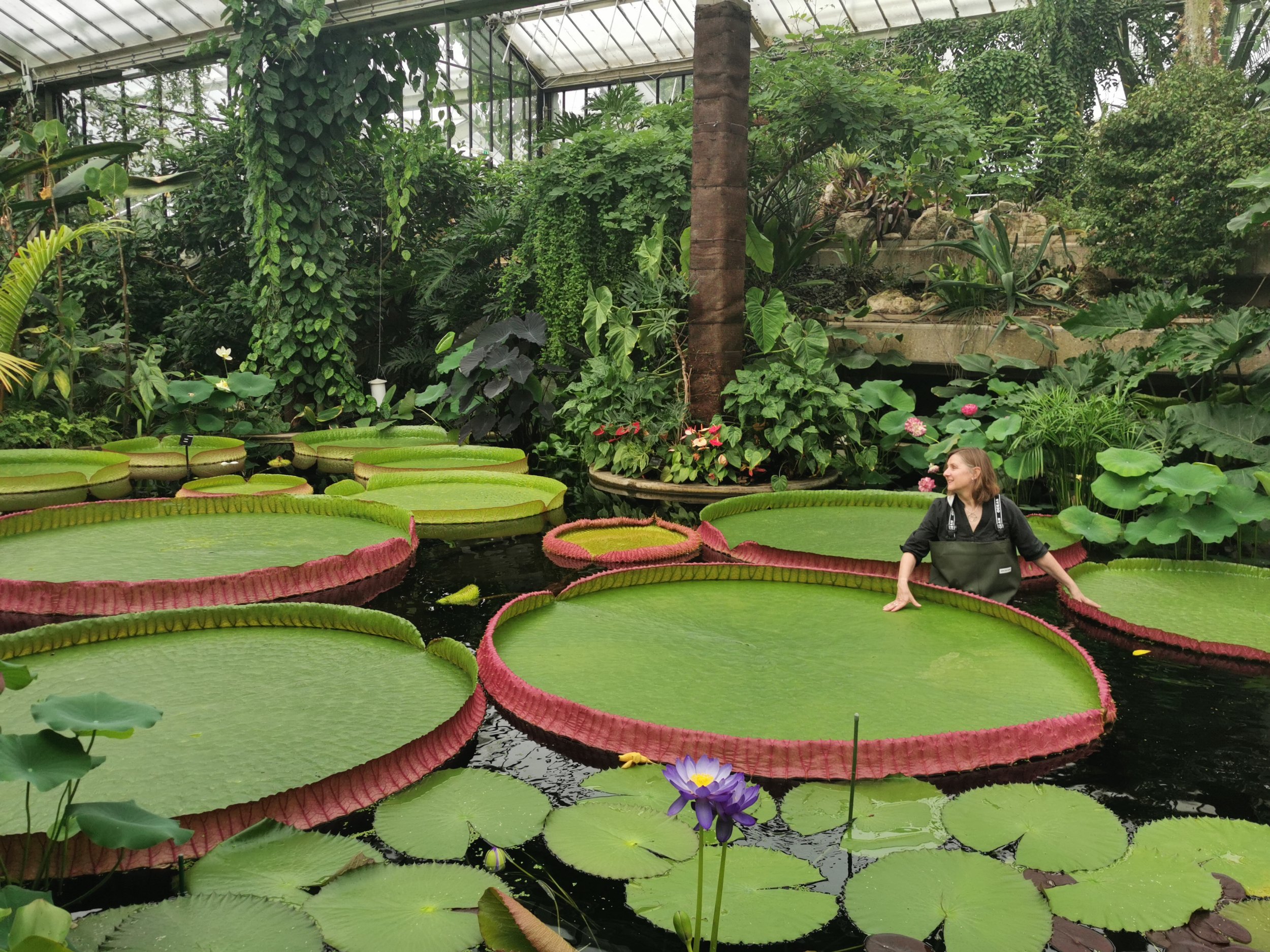VICTORIA BOLIVIANA - A NEW SPECIES OF GIANT WATERLILY: 4th july 2022
For the past four years I have been working with horticulturist Carlos Magdalena and a wonderful team of scientists from Kew and Bolivia to describe and name the first new species of giant waterlily in over a century. It has been quite an undertaking. As a scientific botanical artist and illustrator, I have worked with botanical taxonomists for over 25 years, helping them to describe new plant species to science. My role has always been to turn their words and observations into clear, informative illustrations. But this was the first time I have ever taken on the description and some of the writing myself. We set out to confirm and publish what Carlos had suspected to be a new species of waterlily since studying pictures of it for many years. Well, I am proud to say - we did it!! How it came about is a bit of a long story, so here we go…
Victoria boliviana (Magdalena and L.T. Smith) Me (left) and Carlos (right) with a cut leaf of the newly-described giant waterlily in the Princess of Wales Conservatory, Royal Botanic Gardens Kew. (c)Ines Stuart-Davidson, RBG Kew.
historical inspiration
My investigations into the giant Victoria waterlilies began in late 2016. Since seeing Walter Hood Fitch’s drawings of Victoria regia from Kew’s collection displayed in the Shirley Sherwood Gallery of Botanical Art in 2014, I’d had a desire to do the kind of scientific watercolour illustration which Fitch created in his lithographs of 1842 and 1851. I could see from his studies of the plant, which included a longitudinal section of the flower, that he was genuinely fascinated by it.
The giant water lilies of the genus Victoria are found only in South America, and consist of two species, Victoria amazonica and Victoria cruziana. Victoria’s flowers uniquely open one at a time, each bud emerging from the depths of the water to the surface. On the first night, they are all white and effectively female, opening just enough to entice and entrap the beetles which pollinate them. On the second night, they dramatically change colour and form. Now the flower is in its male stage, releasing pollen and freeing the beetles within it so they can take that pollen to another first-night flower. I decided to try and capture and illustrate the different forms of each species’ flower as they appear on the first- and second-night opening, and in doing so help define the species more clearly.
“Victoria regia - Analyses” lithograph by Walter Hood Fitch, published in his 1851 work “
Victoria regia; Illustrations of the Royal Waterlily,
in a series of figures chiefly made from specimens flowering at Syon and at Kew by Walter Fitch; with descriptions by Sir W. J. Hooker”
Walter Hood Fitch was a prolific botanical artist who made illustrations for Kew from 1834 - 1877. He had previously illustrated Victoria from preserved specimens collected in Bolivia by Mr Bridges in 1845, which were given to William Hooker, the Director of Kew, to study. I later discovered that the herbarium specimen made from that plant is now proven to be the oldest known collection of the new species, Victoria boliviana. It had been misidentified as V. amazonica for an amazing 177 years! But that is a story for another blog….
An illustration project begins
Every year at the Royal Botanic Gardens, Kew, the two known species of the genus Victoria are planted out for display in the ponds of the Waterlily House and the Princess of Wales Conservatory. In November 2016, as the giant waterlilies in the Princess of Wales Conservatory were coming to the end of their growing season, I plucked up the courage to ask the horticulturalists there for a spent flower. They happily obliged and thus my illustration project began. Over the next five growing seasons - the plants are grown from seed every year, flowering in the European summer before dying off at the end of the year - I spent many early mornings and late nights in the Princess of Wales Conservatory trying to capture those flowers at the perfect point of each night’s opening. Once the flower reached the perfect moment of opening, a member of Kew’s horticultural staff would cut the flower for me, leaving me to photograph, draw and dissect the flower as quickly as possible before it lost its form.
It was not always possible to cut a flower for my studies. In this case, the flower was needed for hand-pollination and seed production, so photography had to suffice.
The first-night flower of this
Victoria amazonica plant in the Princess of Wales Conservatory at Kew, was still open at around 7am, in July 2019. It quickly began to close for the day. Later the same evening, it would re-open, changing form and colour dramatically. These changes reflect the pollination process in the wild.
Second-night flowers tend to open much later in the evening.
In order to observe these I had special permission to stay in the glasshouse after dark, along with a generous volunteer from the horticultural team. Getting everything to line up was a challenge, and even once the people were in place, the flowers did NOT always co-operate!
Photo: Jean-Michel Touche
in the meantime - AN UNUSUAL PLANT IN BOLIVIA
Carlos, a botanical horticulturist at Kew, had long been obsessed with Victoria. His job in Kew’s Tropical Nursery was to germinate seeds and grown baby plants for display in the glasshouse ponds. He was intrigued by images spied online of an unusual-looking Victoria in Bolivia. In 2016 he was gifted some seeds of this unusual plant from the Santa Cruz Botanical Gardens. In early 2018, the first baby plants were ready for planting out. I was initially disappointed when I heard this would be planted out instead of Victoria amazonica. The previous year, the plant believed to be V. amazonica turned out to be an accidental hybrid instead, which meant I’d have to wait another year for a good V. amazonica specimen. But at the time I said “Oh well.. if it does end up being different, at least I will be on hand to record it.” The plant was believed to be related to Victoria cruziana, so it was given the working name “aff. cruziana.”
victoria at kew
The plant had a shaky start - it grew slowly, and its leaves were deformed. It was threatened with removal until suddenly it began to sprout beautiful, large leaves with a distinctive shape and strongly coloured rims (the upturned edges of the leaves). The flowers were also different - although it was difficult to say exactly how. For all the Victorias, a flower cannot be spared until the horticulturalists have self-pollinated several flowers to ensure seed for the next year’s display. In July 2018 I was finally allowed a flower of this plant. With special permission, I stayed in the Princess of Wales Conservatory long after closing time. Unlike the V. cruziana second-night flower I had waited patiently for the previous year, this time the flower opened quickly - taking me by surprise by fully opening when I went to make a cup of tea. It was large, beautiful and very different to the others I had seen so far. By the end of the growing season I had observed all stages of the flower, from bud to opening. Carlos was impressed that the seed harvest had remained true to form as well. The seeds were much larger than V. cruziana, and had a distinctive raphe (a ridge at the top of the seed). I began to draw as quickly as possible in order to record the flowers’ characteristics.
The beautiful second-night flower of Victoria boliviana which opened at Kew on July 18th, 2018. It faced away from the viewing path of the Princess of Wales Conservatory, so I had to balance my camera on top of the high wall of the pond. I was always fearful it would fall in! This flower opened so quickly, I missed a part of the process thanks to making a cup of tea. Once it appeared to have finished opening, it was cut for me and I began a long night of photographing, dissecting and drawing. (c)LucyTSmith
a plan is hatched
In 2019 I was finally able to draw a perfect V. amazonica specimen in the Princess of Wales Conservatory. Now I had all three drawn. I showed them to the botanists I worked with in the Kew Herbarium, asking: “do these look different enough to you, and do you think we should try to name a new species?” Their reactions were encouraging. Carlos and I decided to try and describe the plant ourselves as a possible new species. We followed the botanists’ advice us to do this properly - by detailed examination of verified herbarium specimens collected in the wild, adding that DNA analysis would enhance the study. Carlos was invited by partners in Bolivia to visit the plant in its natural habitat there where he and staff from the Santa Cruz Botanical Gardens made herbarium specimens of it. Carlos was thrilled when the wild specimens matched all of our previous observations.
Life-sized pencil drawing of Victoria boliviana’s second-night flower, observed at Kew in July 2018. The flower measured 32 cm across. (c)LucyTSmith, 2019
scientific investigation
However, it was impossible to suggest a new species without first re-defining the existing two species. Their taxonomy was confused and frequently mis-identifications were made, even in the scientific literature. The whole (admittedly small) genus would need to be revised. A team was formed. At Kew alongside myself and Carlos; Alex Monro, an experienced taxonomist, became our guide and senior author. Natalia Przelomska and Oscar Pérez-Escobar under Alex Antonelli would employ the latest techniques to conduct deep DNA analysis. From Bolivia, we were joined by Darío Melgar-Gomez and Gloria Gutierrez-Sibauty, Gaston Riberio-Guardia, César Salazar and Stephan Beck. Stephan Beck, from the Bolivian National Herbarium, had collected the species in Bolivia 44 years ago, and his specimen became the type. Also included in the team were Kew scientists working on conservation assessments and chromosomes. See the full author list and acknowledgements here in the Frontiers in Plant Sciences Paper - it is a long list, reflecting the team work that went into the paper.
Drawing informs taxonomy: as I drew the buds of all three species, I began to notice that the carpellary appendages (drawn darker here) which surround the ovary’s stigmatic surface, were a unique shape for each species. This “character” is a new way to tell the species apart, and can be observed in both living material and well-pressed flower specimens.
Buds of V. cruziana (left) and V. amazonica (right) in longitudinal section; drawn from life from plants grown at Royal Botanic Gardens, Kew. (c) LucyTSmith 2019
My original work on the watercolour illustrations was put on hold, as instead we began the meticulous work of data gathering from herbarium specimens and iNaturalist records, morphological analysis, the writing of detailed species descriptions of all three species, geo-referencing. Instead of working on my watercolour illustrations, I switched back to the typical pen and ink methods which, until now, I had used to help other taxonomists describe their new plants. Now, for the first time, it was up to me to direct the content of the illustrations. As I drew, I learnt more and more about the structures of the plants’ flowers and leaves. Thus the illustration helped to inform the descriptions and define new characters with which to tell the species apart.
Using botanical illustration to compare the bud and seed forms of all three species (top to bottom) V. amazonica, V. boliviana, V. cruziana. We also discovered new ways to tell the flowers apart, using the shapes and sizes of the inner parts; and by quantifying the differences in prickles on the outer tepals. The next two illustrations show V. boliviana flower on its first- (left) and second-night (right) openings (not included in the paper).
We examined hundreds of herbarium specimens and iNaturalist records. The herbarium specimens allowed us to study details of the plants up close, while the iNaturalist records allowed us to observe gross morphological features that were lost in a pressed specimen. Both sources proved us with geographical information which was collated and put into distribution maps. The plants grown at Kew allowed us to observe and measure features such as the rim heights of the leaves, and informed all of the illustrations. We wrote new descriptions for all the species, finding new ways to tell them apart. The most difficult part of the paper was keeping it concise enough - but finally the team did it. The paper was accepted for publication in Frontiers in Plant Sciences, and released on the 4th July, 2022, almost four years to the day on which it first flowered at Kew. The name “Victoria boliviana” was born!
Scientific illustration in pen and ink of Victoria boliviana (sp nov.) published in our paper “Revised species delimitation in the giant water lily genus Victoria (Nymphaeaceae) confirms a new species and has implications for its conservation,” published in Frontiers in Plant Science, July 4th 2022. I illustrated all three species in this way, to encapsulate their unique features in one image (c)LucyTSmith
So, how about those watercolours that I had started before all of this took off? To date I have nearly completed several large paintings of all three species’ flowers in bud and on their first- and second-night opening. During the pandemic I painted a life-sized Victoria amazonica leaf! All of this was put on hold so that I could write and illustrate the paper. I hope those illustrations will help to define the species for years to come. Now it’s time for me to get back to the original paintings - there is still so much to do, not to mention finding an exhibition space for them. But, I believe the “diversion” was worth it.
Lucy in the Princess of Wales Conservatory Pond in July 2022. Victoria boliviana, the new species which has been hiding in plain sight for some time, will now be known to everyone! You can see all three species growing side-by-side at Kew right now. Photo: Carlos Magdalena








